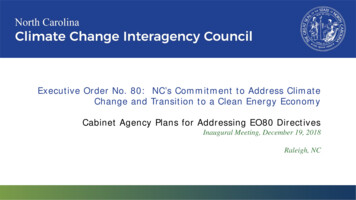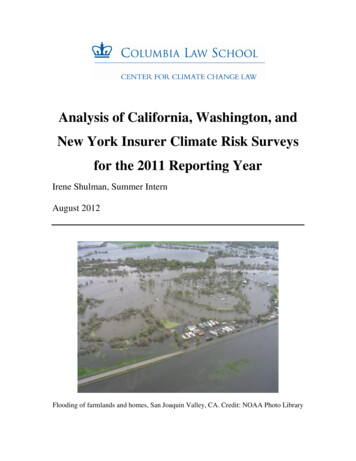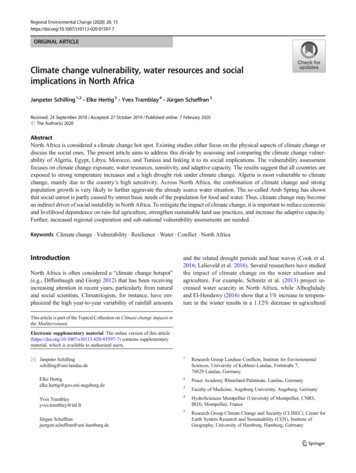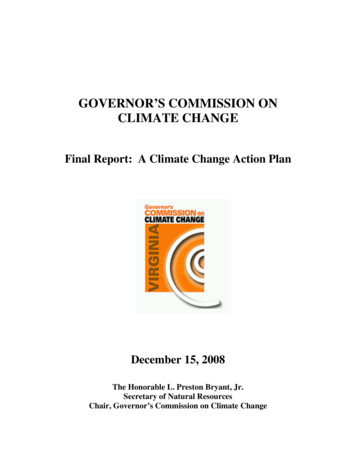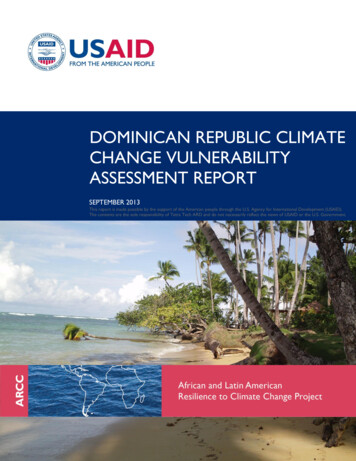
Transcription
Florida Climate Change Education andTraining: State University SystemCooperative PlanDecember 2011Principal AuthorSebastian Galindo-GonzalezContributing AuthorsLeonard BerryCarolyn CoxAlana EdwardsRobert EllingsonAllan FeldmanTracy A. IraniJames W. JonesJulie LambertChristine LockhartMantha MehallisJeffrey G. RyanSupported by the State University System of Florida
December 2011FLORIDA CLIMATE CHANGE EDUCATION ANDTRAINING: STATE UNIVERSITY SYSTEMCOOPERATIVE PLANPrincipal Author:Sebastian Galindo-GonzalezContributing Authors:Leonard BerryCarolyn CoxAlana EdwardsRobert EllingsonAllan FeldmanTracy A. IraniJames W. JonesJulie LambertChristine LockhartMantha MehallisJeffrey G. RyanGalindo-Gonzalez, S., L. Berry, C. Cox, A. Edwards, R. Ellingson, A. Feldman, T.A. Irani,J.W. Jones, J. Lambert, C. Lockhart, M. Mehallis, J.G. Ryan, 2011: Florida Climate ChangeEducation and Training: State University System Cooperative Plan, Florida Climate ChangeTask Force. [Available online at http://floridaclimate.org/whitepapers/]i
AUTHORSLeonard Berry, DirectorFlorida Center for Environmental StudiesCoordinator FAU Climate Change InitiativeFlorida Atlantic UniversityCarolyn CoxCoordinator Florida Climate InstituteUniversity of FloridaAlana EdwardsEducation & Training CoordinatorCenter for Environmental StudiesFlorida Atlantic UniversityRobert EllingsonProfessorDepartment of Earth, Ocean and Atmospheric ScienceFlorida State UniversityAllan FeldmanProfessor of Science EducationDepartment of Secondary Education, College of EducationUniversity of South FloridaSebastian Galindo-GonzalezResearch Assistant ProfessorDepartment of Agricultural Education and CommunicationUniversity of Floridaii
Tracy A. Irani, DirectorCenter for Public Issues Education in Agriculture Natural ResourcesDepartment of Agricultural Education and CommunicationUniversity of FloridaJames W. Jones, DirectorFlorida Climate InstituteUniversity of FloridaJulie LambertAssociate Professor of Science EducationDepartment of Teaching and LearningFlorida Atlantic UniversityChristine LockhartResearch AssistantCenter for Environmental StudiesFlorida Atlantic UniversityMantha MehallisDirector and ProfessorEnvironmental MBA ProgramCollege of BusinessFlorida Atlantic UniversityJeffrey G. RyanProfessor and ChairDepartment of GeologyUniversity of South Floridaiii
ACKNOWLEDGMENTSThe authors acknowledge Hannah Carter (Assistant Professor in the Department ofAgricultural Education and Communication; University of Florida), Paul Ruscher (AssociateProfessor of Meteorology; Florida State University), Doug Parsons (Partnership Coordinator;Florida Fish & Wildlife Conservation Commission), and Michael Spranger (Associate Deanfor Extension, Environmental and Natural Resources Programs; University of Florida) forproviding useful review comments on an earlier version of this white paper. The support ofthe cluster grant of the State University System of Florida is recognized.Front cover photo credits (clockwise from left): NASA, UF, FSU, USFiv
Table of ContentsSECTION 1: INTRODUCTION . 1CLIMATE CHANGE EDUCATION IN FLORIDA: A BRIEF ANALYSIS . 4OBJECTIVES . 5SCOPE OF PAPER . 5SECTION 2: CLIMATE CHANGE EDUCATION ASSESSMENT IN FLORIDA:METHODS AND PROCEDURES . 6SETTING. 6DATA COLLECTION METHODS . 6Course Identification . 7Identifying Other Educational Initiatives . 9DATA ANALYSIS METHODS . 9SECTION 3: CLIMATE CHANGE EDUCATION CURRENTLY OFFERED INTHE SUS. 11FORMAL EDUCATION . 11Graduate and Undergraduate Programs and Courses (Organized by University) . 11University-Based K-12 Education Programs. 21NON-FORMAL EDUCATION . 25Cooperative Extension Programs . 25Outreach & Continuing Education Programs . 27RESEARCH CENTERS AND INSTITUTES . 28SECTION 4: OTHER SOURCES OF CLIMATE CHANGE EDUCATION INFLORIDA . 36OUT-OF-STATE UNIVERSITIES WORKING LOCALLY . 36GOVERNMENTAL AGENCIES . 37NON-GOVERNMENTAL ORGANIZATIONS . 42PRIVATE SECTOR . 43SECTION 5: UNMET CLIMATE EDUCATION NEEDS IN FLORIDA . 45STATE OF CLIMATE CHANGE EDUCATION . 45EDUCATIONAL NEEDS . 47SECTION 6: NEXT STEPS . 49CLIMATE CHANGE EDUCATION FOR THE FUTURE . 49APPROACH 1: PROFESSIONAL DEVELOPMENT . 49APPROACH 2: INTER-INSTITUTIONAL CERTIFICATE ON CLIMATE CHANGE . 50EPILOGUE . 52v
REFERENCES . 53APPENDIXES . 57APPENDIX I – MESSAGE FOR STRATEGY A . 57APPENDIX II. MESSAGE 1 FOR STRATEGY B . 58APPENDIX III. MESSAGE 2 FOR STRATEGY B . 59APPENDIX IV. LIST OF COURSES BY INSTITUTION . 60APPENDIX V. GUIDING QUESTIONS FROM BREAKOUT SESSION .71APPENDIX VI. TAKING COURSES ACROSS THE FLORIDA STATE UNIVERSITY SYSTEM . 72APPENDIX VII. ADDITIONAL RESOURCES. 74vi
LIST OF FIGURESFigure 1: Graduate and undergraduate courses are important areas to advance climate scienceliteracy. Courtesy of UF/IFAS. . 5Figure 2: Items included in the pre-workshop questionnaire at the 1st Climate Change TaskForce Workshop in Boca Raton, Fl. March 18, 2011. . 7Figure 3: Suggested criteria to classify the identified courses based on their relationship toclimate change. . 8Figure 4: Students walking outside of UF’s Marston Science Library. Courtesy of UF/IFAS. 9Figure 5: Campus of the Florida Agricultural and Mechanical University. Courtesy ofFAMU. . 12Figure 6: Campus of the Florida Atlantic University. Courtesy of FAU. . 13Figure 7: Campus of Florida State University. Courtesy of FSU. . 15Figure 8: University of Florida’s main entrance. Courtesy of UF/IFAS. .17Figure 9: Marshall Student Center at the University of South Florida. Courtesy of USF. . 20Figure 10: College of Education at the University of South Florida. Courtesy of USF. . 22Figure 11: Emerson Alumni Hall at the University of Florida. . 23Figure 12: Dr. Eric Chassignet and Dr. James Jones, Co-Director and Director of the FloridaClimate Institute. Courtesy of UF/IFAS. . 29Figure 13: Researchers from UF and UM collaborate in a variety of climate-related projectsthrough the Southeast Climate Consortium. Courtesy of UF/IFAS. . 35Figure 14: The 2nd Climate Change Task Force Workshop on November 14-15, 2011 broughttogether representatives from academia, governmental agencies, NGOs, and private sector todiscuss about cooperation in climate change. Courtesy of UF/IFAS. . 39Figure 15. The Florida Center for Environmental Studies (CES) is housed at FAU’s Jupitercampus. Courtesy of FAU. . 43Figure 16: UF students work on their assignments in front of the Green Pond conservationarea. Courtesy of UF/IFAS. . 52LIST OF TABLESTable 1. Graduate(G) and undergraduate (U) courses offered by institution, organized bylevel of climate change content and branch of science. . 24Table 2. Climate-related courses taught at each institution. 46vii
LIST OF ABBREVIATIONS AND l Areas Climate Change Education PartnershipCESCenter for Environmental StudiesCOAPSCenter for Ocean-Atmospheric Prediction StudiesFAMUFlorida Agricultural and Mechanical UniversityFAUFlorida Atlantic UniversityFCIFlorida Climate InstituteFGCUFlorida Gulf Coast UniversityFIUFlorida International UniversityFSCFlorida Sea GrantFSUFlorida State UniversityIPCCIntergovernmental Panel on Climate ChangeNASNational Academy of SciencesNCFNew College of FloridaSECCSoutheast Climate ConsortiumSUSState University SystemUCFUniversity of Central FloridaUFUniversity of FloridaUMUniversity of MiamiUNFUniversity of North FloridaUSFUniversity of South FloridaUSGCRPUnited States Global Change Research ProgramUWFUniversity of West Floridaviii
EXECUTIVE SUMMARYGlobal climate changes are complex and challenging to communicate to society. As aconsequence, society is not prepared to adapt and mitigate the impacts of climate change,remaining incapable of pushing for effective, efficient, and equitable policies and actions onthe matter. This challenge is evident in the Southeastern United States, where broad sectorsof the public remain unconvinced that climate change is a serious problem and scientists andeducators in general lack sufficient capability to translate sciences to lay audiences, making itharder for people to understand climate change and how and when they should be concernedand take action. Therefore, it is important to identify existing educational opportunities thatand others that are still needed to broadly educate and inform relevant audiences.The overall goal of this paper is to provide information on university climate changeprograms (research and education), university climate change institutes and centers, andinitiatives statewide in Florida. The specific objectives are:1) describe the current status ofclimate change education within Florida, b) assess the extent at which climate changeeducational needs are being addressed, and c) identify action items required to enhanceclimate literacy of the State’s population.Through a systematic statewide effort, 461 courses with varying degrees of climatechange content were identified within 12 surveyed institutions of higher education. Almost40% of these courses are taught in disciplines within the Earth and physical sciences, and boththe life and social sciences have around 100 courses each. The rest of the courses were part ofthe curricula of interdisciplinary programs (43), and humanities (8). The courses were furtherclassified based on the amount of climate change content that they included.A set of educational needs were identified. The most important needs are: a) promotea stronger integration of climate change education with other sciences and disciplines; b)enhance students’ access to current and future courses; c) develop the skills of scientists fortranslating scientific concepts to lay audiences; and d) strengthen the preparation of teachingand extension faculty and K-12 science teachers to incorporate climate change concepts intheir courses. Two approaches are proposed by the authors based on these findings and onrecent publications, such as the USGCRP Climate Literacy framework. The first one focuseson the development and delivery of training curricula to enhance the knowledge and skills ofuniversity faculty (both teaching and extension) and K-12 science teachers in two main areas:1) the integration of climate change education into their courses/programs, and 2) thetranslation of scientific concepts to multiple audiences. The second approach is theestablishment of a state-wide, inter-institutional, and multidisciplinary concentration orminor/certificate on climate change. This program would enhance the access of students to avariety of courses on climate change, improve the capacity of future scientists for translatingsciences, and promote the integration of climate change education into a range of disciplines.ix
SECTION 1: INTRODUCTION“If a man empties his purse into his head, no man can take it away from him.An investment in knowledge always pays the best interest.”Benjamin Franklin (1706-1790)Society is not prepared to respond to climate change because the climate-relateddecisions and policies that need to be made over the next decades will require a citizenry thatis better informed and more engaged than it is today (NRC, 2010a). History shows thatsociety has successfully coped with and adapted to the existing relatively stable climatevariability; the challenge now is to respond effectively to the threats presented by climatechange (NRC, 2010b). All types of decision-makers (e.g. governments, businesses, andindividuals) are already taking actions to respond to climate change (NRC, 2010c). However,large segments of society still remain unconvinced that climate change is real (Kohut et al.,2009) and, therefore, these segments remain inactive. Society as a whole must realize thatclimate change is happening and that human activity is playing a part in this change (NRC,2011; Hassol, 2008).Recent surveys show that the American public wants more information about climatechange and the ways in which it may affect their lives; citizens also expect responsive actionfrom the government and are willing to take action themselves (NRC, 2010a). The truth isthat global climate changes are complex and challenging to communicate to society. Anunderstanding of science is fundamental to appreciating the forces that produce climatechange and the effect of changing climate on different regions of the world. However,science education is not available to everyone and scientists and educators, in general, lacksufficient capability to translate sciences to lay audiences. This situation makes it difficult forpeople to become informed or educated about climate science. As a consequence, societylacks the knowledge and skills to modify its behaviors to adapt to the effects, or mitigate,climate change.Greater awareness or knowledge about climate change may lead to a more engagedcitizenry (Kahlor and Rosenthal, 2009), but only if special attention is directed to the culturaldiversity of our audiences when tailoring messages aimed at generating a sense of urgencyand being a cue to act (Kahan et al., 2011). The sustainability of our society within an everchanging climate, regardless of the source of change, requires that we place climate scienceeducation, including education about climate change, on a level of education similar to that ofthe basic sciences, such as biology, chemistry, and physics. This is consistent with NRC’srecommendation in its report on Informing and Effective Response to Climate Change(2010a), “The federal government should establish a national task force that includes formal1
and informal educators, government agencies, policymakers, business leaders, and scientists,among others, to set national goals and objectives, and to develop a coordinated strategy toimprove climate change education and communication.”Climate change is a global concern and may have significant negative effects onagriculture, ecosystems, and human health (IPCC, 2007). Scientists predict that the effects ofclimate change on human and natural systems will increase over the next several years(USGCRP, 2009). Taking action today to mitigate climate change impacts is costly (0.7 to3.5% of GDP), however, these costs will double, or triple, for each decade that action isdelayed (Stern, 2006). Even though this type of economic analysis has led policy makers toenact legislation to mitigate and adapt to climate change (e.g. 23 states in the U.S. haveestablished targets to reduce greenhouse gas emissions; NRC, 2010a), public opinion is stillwidely divergent on climate change (Leiserowitz and Broad 2008; Leizerowitz et al. 2009).Recent studies of society beliefs about climate change indicate that the public lacks abasic understanding of science and its methods (Kohut et al., 2009; Maibach et al., 2009).Additionally, public opinion about climate change is largely influenced by politicalpreferences (Hamilton, 2009). Sometimes, it appears that political orientation is a strongerdeterminant of attitudes towards climate change than other demographic attributes. Thepoliticization of the debate on climate change has led members of the public to perceive itmore as a matter of personal opinion or a political ideology, distracting attention from theknown facts about climate change and the basic causes of those changes (Furman et al. 2009).Consequently, there is an acute and demonstrable need to better educate and inform decisionmakers and citizens in general on the most basic facts of climate change (Hassol, 2008), todevelop a more climate science literate society. Numerous reports highlight the need for thepublic to better understand science and engineering (National Academies of Science, 2006;National Research Council, 2009; US Department of Education, 2002).This challenge is evident in the Southeastern U.S., where broad sectors of the publicremain unconvinced that climate change is a serious problem (Kohut et al., 2009). As aconsequence of this deficiency of education and awareness, society lacks the means to adaptto and mitigate the impacts of climate change, remaining unable to enact effective, efficient,and equitable policies and actions on the matter. For example, in the U.S. policy-makers arelimited in what they can do to address this issue, because even though some significant effortsto reduce greenhouse gas emissions are being implemented at the state and local levels, thecountry still lacks a set of national goals and polices to frame and coordinate the efforts ofindividuals, organizations, and governments (NRC, 2010d). A society with a comprehensivebackground in climate literacy is able to develop and implement effective risk-managementstrategies (NRC, 2010b). The connection between adaptation and risk assessment is evidentin the case of hurricane preparedness. Coastal communities spend large sums of money onhurricane preparedness, but most will likely never get hit by a hurricane, however, the riskassociated with it is communicated through governmental structures, so investment is2
justified. Policy-makers will need to closely monitor the impacts of actions implemented toadapt or mitigate climate change to learn and improve the effectiveness of response options(NRC, 2010b).Global Climate Change Education: a SynopsisEducating citizens to develop a more climate literate society is currently a criticalneed. Climate science literacy is “the understanding of your influence on climate andclimate’s influence on you and society” (USGCRP, 2009), and a climate literate citizenry iscrucial in order to make informed decisions that will influence one’s own quality of life andsensible public policy. There is a need to advance climate science literacy across thespectrum of education, but one of the most important areas to target may be at the graduateand undergraduate levels of higher education, where future scientists as well as informedopinion leaders have the potential to disseminate their knowledge broadly through formal andnon-formal education channels. However, in the case of climate change education,universities have generally responded in a “lethargic” way to their responsibility to educateabout important societal issues (Lemons, 2011).It has been proposed that, regardless of their major, university students should beenvironmentally aware and literate (McIntosh et al., 2001). According to Lemons (2011),institutions of higher education must recognize their responsibility in responding to the urgentneed of global climate change. However, even though some universities have successfullyimplemented different education models to integrate environmental education into existingcourses, this is an area in need of great improvement (Rowe, 2002). Rowe found that studentsusing these models have a greater concern about the future of society, believe that they canmake a difference, and are willing to participate in solving society’s environmental problems.The full commitment of the higher education system will be required to make the neededchanges to face this challenge; changes may include incorporating content on the underlyingcauses of climate change and strategies for its mitigation in courses across all disciplines(Lemons, 2011). Expanding climate change education into disciplines such as the socialsciences is necessary to bring scholars that can contribute their expertise to promote publicengagement and understanding through communication and to extend the discussion on theethics of climate change (Mailbach and Priest, 2009).There is a wide range of educational programs focusing on climate education aroundthe world. Formal and non-formal education on the causes and consequences of climatechange has been accelerating over the past decade. Leadership for this effort in the U.S. hascome primarily from governmental institutions. These efforts are summarized in the latestedition of the U.S. Climate Action Report (United States Department of State, 2010). Thecurrent scientific consensus on climate change is summarized in (NRC Board on AtmosphericSciences and Climate, 2010). Related documents have focused on the effects of climate3
change in Florida and the Gulf Coast (Florida Fish and Wildlife Conservation Commission,2008; Florida Oceans and Coastal Council, 2009; Sole, 2008; Twilley, et al., 2001).Climate Change Education in Florida: a Brief AnalysisThe Southeastern U.S. is particularly vulnerable to climate change due to its highinherent biodiversity and agricultural diversity, tenuous water resources, coastal topography,and high population growth (Climate Change Science program, 2008). Significant climatechange may bring about serious agricultural, economic and environmental challenges to theregion, creating an acute need to educate agricultural producers, public and policy makers tobetter understand, mitigate and/or adapt to future climate. The main issues facing this regionin terms of climate variability and change are significant and are available in much moredetail elsewhere (e.g. USGCRP 2009). In brief though, some of the main issues affecting thisregion include: a) changes in precipitation patterns; b) average annual temperatures areprojected to rise, c) sea-level rise is projected to accelerate, increasing coastal inundation andshoreline retreat, and d) the frequency and intensity of tropical cyclones may change, therebysubjecting the region to more or less rainfall and possibly higher wind speeds. The ‘GlobalClimate Change Impacts in the United States’ report for the Southeastern region (Karl et al.2009), explains that one of the ways in which the projected increases in air and watertemperatures will affect the quality of life is by causing heat-related stresses for people,plants, and animals.As noted by Lemons (2011), climate change education in the U.S. is at its “infancy”,even though scientists have reported the severe and irreparable dangers of climate change foryears. A real pressure exists on climate change education to develop and “mature” as soon aspossible if society is going to respond on time and effectively to climate change challenges.This is specially urgent in Florida where most people do not consider climate change arelevant issue and do not identify the global rise of temperatures as a consequence of humanactivities (Kohut et al., 2009) and scientists and educators in general lack the capability totranslate sciences to lay audiences, making it harder for people to become informed oreducated about climate science. The higher education system has ignored its responsibility toeducate society on climate change (Lemons, 2011) and today it is more urgent than ever todevelop the required social and human capital necessary to broadly educate and informrelevant audiences with a view toward increasing the number of scientists, educators, andopinion leaders who understand the impacts, possess the means to adapt and mitigate theseimpacts, and have the capacity to teach and inform others.4
ObjectivesThe overall goal of this paper is to provideinformation on university climate change programs(research and education), university climate changeinstitutes and centers, and initiatives statewide inFlorida. The specific objectives are: Describe the current status of climate changeeducation within Florida. Assess the extent at which educational needsrelated with climate change are being addressed. Identify action items required to enhanceclimate literacy of the State’s population.Scope of PaperFigure 1: Graduate and undergraduatecourses are important areas to advanceclimate science literacy. Courtesy ofUF/IFAS.The main object of study of this document is theformal and non-formal educational curricula on climate change available in Florida.Therefore, an account of related graduate and undergraduate courses, outreach andprofessional development programs, and other educational initiatives sponsored, developed,and/or delivered by institutions of higher education, governmental agencies, nongovernmental organizations, and the private sector is included. However, it is not possible toclaim that the information presented in this document is an exhaustive account of the climatechange education in Florida because there are multiple challenges to identifying all educationprograms on climate change. The main challenge is that climate change education is verydiverse and approached from a variety of disciplines and philosophical perspectives (e.g.quantitative courses in Meteorology vs. qualitative courses in Anthropology). The instructorsof these different courses/programs are dispersed and, in most cases, do not share otherscholastic activities. This makes it very difficult to identify those who are teaching topics onclimate change, how are they framing the issues, and what types of outcomes they expectfrom their learners.5
SECTION 2: CLIMATE CHANGE EDUCATION ASSESSMENT IN FLORIDA:METHODS AND PROCEDURES“The result of the educative process is capacity for further education.”John Dewey (1859-1952)SettingEleven public universities distributed across the state form the State University Systemof Florida (SUS) and currently serve more than 300,000 students. These institutions are:Florida Agricultural and Mechanical University (FAMU), located in Tallahassee; FloridaAtlantic University (FAU), located in Boca Raton; Florida Gulf Coast University (FGCU),located in Fort Myers; Florida International University (FIU), located in Miami; Florida StateUniversity (FSU), located in Tallahassee, New College of Florida (NCF), an autonomoushonors college located in Sarasota; University of Central Florida (UCF), located in Orlando;University of Florida (UF), located in Gainesville; University of North Florida (UNF), locatedin Jacksonville; University of South Florida (USF), located in Tampa; and University of WestFlorida (UWF), located in Pensacola. The SUS is under the administration of the FloridaBoard of Governors. The higher education system in Florida is integrated by SUS and theFlorida College System. This white paper presents an overview of the ongoing educationalefforts related to climate change conducted within the SUS. In addition to these institutions, itwas decided to include the efforts of the Univers
Environmental MBA Program College of Business Florida Atlantic University Jeffrey G. Ryan Professor and Chair Department of Geology University of South Florida . iv ACKNOWLEDGMENTS . FGCU Florida Gulf Coast University FIU Florida International University FSC Florida Sea Grant



